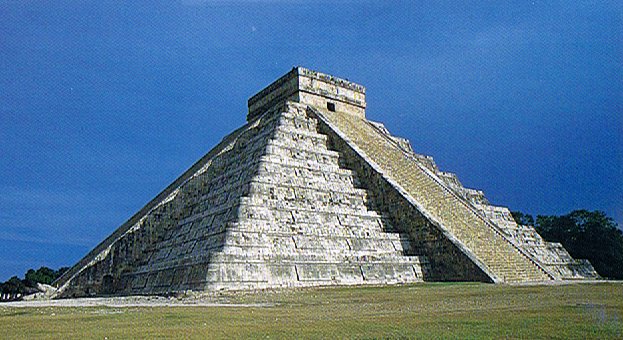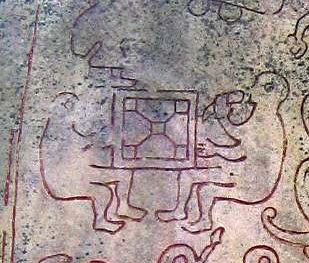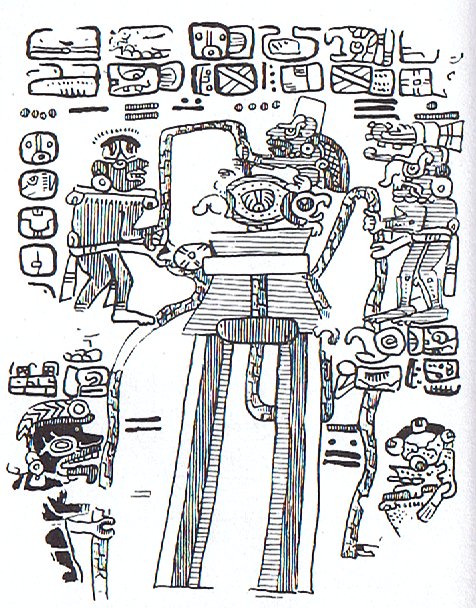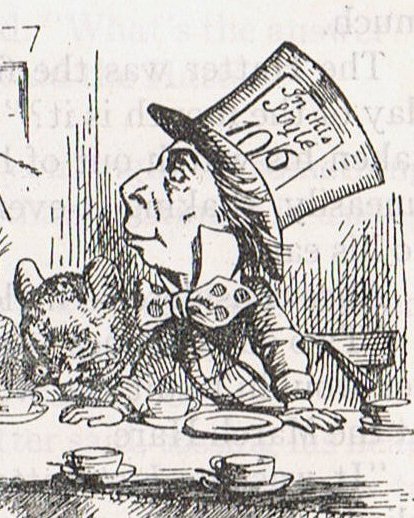Bb12-4
Once again. The B and C text are somewhat similar in structure,
because the numbers of glyphs on each side are not in balance:
|
B |
side a |
10 |
421 |
|
side b |
10 |
418 → 840 - 422 |
|
2 |
88 |
|
C |
side a |
14 |
392 → 348 +
44 |
|
side b |
14 |
348 |

 |
 |
 |
|
Ca13-4 |
Ca13-5 (348) |
Ca13-6 |
|
tagata ma te kihikihi |
koia ra kua oho |
|
March 2 |
3 (428 = 80 +
348) |
4 (63) |
|
'Febr 4 (400 = 427 - 27) |
5 (36) |
6 |
|
ι Cephei (346.0), λ Aquarii, γ Piscis Austrini,
σ Pegasi (346.5) |
SCHEAT AQUARII = δ
Aquarii
(347.0),
ρ
Pegasi (347.2),
δ
Piscis Austrini (347.4),
FOMALHAUT (Mouth of the Fish) =
α
Piscis Austrini,
τ
Gruis (347.8)
*306.0 = *347.4 - *41.4 |
FUM AL SAMAKAH (Mouth of the Fish) =
β
Piscium
(348.3),
ζ
Gruis (348.5),
ο
Andromedae (348.9) |
|
No star listed (164)
ALTAIR (α
Aquilae) |
Wings-27
(Snake)
η
Octans (165.4), ALKES (Shallow Basin) =
α
Crateris
(165.6)
*124.0 = *165.4 - *41.4 |
ANA-TIPU-4
(Upper-side-pillar - where the guards stood)
MERAK (Loin, not Lion) =
β
Ursae Majoris
(166.2),
DUBHE (Bear) =
α
Ursae Majoris
(166.7) |
|
Sept 1 |
2 (245) |
3 (63 + 183) |
By adding together the number of glyphs in the 20 first lines on the B
tablet, 421 + 418 = 839, we can infer that we perhaps
ought to add the empty glyph space
at Almaaz at the beginning of the text: 1 +
421 = 422 = 840 - 418. 840
→ 84 → the day number for the Julian equinox ('March 25).
The sum of glyphs on the C
tablet, 392 + 348 = 740, similarly suggests 10 times the right
ascension day number for Almaaz
(*74).
The
first glyph on side a of the C text probably corresponds to
the first day after 0h (→
the Gregorian spring equinox, March 21 at Sirrah).
392 is an even number and the heliacal position of
Sirrah (the Navel of the Horse) at 0h should then not be
counted.
... Time flows on and not until its
measures have been completed in full can there be
notches (nights) carved into the wood ...

The end of the Pegasus Square, the
Wall of the
House at the top of the year, had a square entrance
(birth) opening in the east for those who - like the
Mayas - were living north of the equator, and this was
reflected (†) in another
square exit opening at autumn equinox:

The C
text has Polaris at the last glyph on its side a and side b
is beginning with glyph number 393. The B text has day 393 (January
28) at the beginning of side b. Why was that so?
A possible explanation might be to show how Polaris (*26.6)
was
located at the north pole in contrast to Dramasa (*320.0) at the
south pole, around 290 right ascension days apart. 320 -
290 =
30 → Hamal
(the Prince).
Or better: 365.25 + 26.6 - 320.0 = 71.85
→
Cb2-21.
26000 / 71.85 = 362.
26000 / 72 = 361 → Vega
(*281.8, 362) → *282 = *202 (Spica) + *80.

 |
 |
 |
 |
 |
 |
 |
|
Bb1-8
(1 + 429) |
Bb1-9 |
Bb1-10 (432) |
Bb1-11 |
Bb1-12 |
Bb1-13 |
Bb1-14
→ 114 |
|
...
On the last day, they issue forth to
battle in martial array. Says
Grimnismal (23): 'Five hundred gates
and forty more - are in the mighty
building of Walhalla - eight hundred
'Einherier' come out of each one gate -
on the time they go out on defence
against the Wolf.' That makes 432,000 in
all, a number of significance from of
old ... [E:16] |
|
DRAMASA =
σ
Oct.,
χ
Capricorni (320.0),
ν
Aquarii (320.3),
γ
Equulei (320.6),
ο
Pavonis (320.8) |
α Oct. (321.5),
δ
Equulei (321.7),
φ
Capricorni (321.8) |
KITALPHA (Part of a Horse) = α Equulei
(322.0),
ALDERAMIN (The Right Arm) =
α
Cephei
(322.9) |
DAI =
ι
Capricorni
(323.5),
β
Equulei (323.8) |
γ
Pavonis (324.1),
YAN =
ζ
Capricorni
(324.6) |
Al Sa'd al
Su'ud-22 (Luckiest of the Lucky)
/
Emptiness-11 (Rat)
TSIN = 36 Capricorni
(325.2),
ALPHIRK (The Flock) =
β
Cephei
(325.7),
SADALSUD =
β
Aquarii,
ξ
Gruis (325.9) |
No star listed (326) |

... In China, with
Capricornus, Pisces, and a part of
Sagittarius, it [Aquarius] constituted
the early Serpent, or Turtle, Tien
Yuen; and later was known as
Hiuen Ying, the Dark Warrior and
Hero, or Darkly Flourishing One, the
Hiuen Wu, or Hiuen Heaou, of
the Han dynasty, which Dupuis gave as
Hiven Mao. It was a symbol of the
emperor Tchoun Hin, in whose
reign was a great deluge; but after the
Jesuits came in it became Paou Ping,
the Precious Vase. It contained
three of the sieu, and headed the list
of zodiac signs as the Rat, which
in the far East was the ideograph for
'water', and still so remains in the
almanacs of Central Asia, Cochin China,
and Japan ... |
|
Febr 4 (400) |
5
(365 + 36) |
6 |
7 |
8
(*324) |
9
(40) |
10 |
|
... On February 9 the
Chorti Ah K'in, 'diviners', begin
the agricultural year. Both the 260-day
cycle and the solar year are used in
setting dates for religious and
agricultural ceremonies, especially when
those rituals fall at the same time in
both calendars. The ceremony begins when
the diviners go to a sacred spring where
they choose five stones with the proper
shape and color. These stones will mark
the five positions of the sacred
cosmogram created by the ritual. When
the stones are brought back to the
ceremonial house, two diviners start the
ritual by placing the stones on a table
in a careful pattern that reproduces the
schematic of the universe. At the same
time, helpers under the table replace
last year's diagram with the new one.
They believe that by placing the cosmic
diagram under the base of God at the
center of the world they demonstrate
that God dominates the universe. The
priests place the stones in a very
particular order. First the stone that
corresponds to the sun in the eastern,
sunrise position of summer solstice is
set down; then the stone corresponding
to the western, sunset position of the
same solstice. This is followed by
stones representing the western, sunset
position of the winter solstice, then
its eastern, sunrise position. Together
these four stones form a square. They
sit at the four corners of the square
just as we saw in the Creation story
from the Classic period and in the Popol
Vuh. Finally, the center stone is placed
to form the ancient five-point sign
modern researchers called the quincunx
...

|
|
DEC 2
(4 * 84) |
3
(337) |
4 |
5 |
6
(340) |
7 |
8 |
|
VISIBLE CLOSE TO
THE FULL MOON: |
|
9h
(*137.0) |
Aug
6
(218) |
7 |
8
(*140) |
AL
MINHAR AL ASAD |
ALPHARD |
ALTERF |
 |

 |
 |
 |
 |
 |
 |
 |
|
Bb1-15 |
Bb1-16 |
Bb1-17 |
→ 4 * 29½ |
Bb1-19 |
Bb1-20 |
Bb1-21 |
|
mai tae rere te manu
ki te mea maa i te
rima |
kua rere ïa ki te
veveke |
mai tae hokohuki - ia
koia ra |
kua rerega a
manu |
rere ki te hetu mai
tae hua ia |
kua haga ia
ki te mea o tona
hare pure |
|
Veve.
Pau.: miserable. Ta.: veve,
poor, needy, miserable. Churchill.
Veveke, to hurry up, hasten,
quicken. Websters.
Pure.
Cowrie (Cypraea caput
draconis); pure vaka, another
type of cowrie, which can float on the
sea like a diminutive boat (vaka).
Vanaga. 1. To pray, to supplicate,
invocation, prayer; hare pure,
church, chapel; tae pure,
irreverence; purega, prayer P
Pau., Mgv., Mq., Ta.: pure, to
pray. In Samoa, Tonga, Niuē,
Futuna, Uvea, pule
means to command. 2. A shell T. P
Pau.: hakapurepure, to dye, to
color. Mq.: pué, the porcelain
shell. Ta.: pure, a mark.
Purepure, spotted, dappled; ragi
purepure, dappled sky. Purepurea,
spotted. P Pau.: hakapurepure, to
dye, to color. Mgv.: purepure,
printed cloth; akapurepure, to
paint in different colors. Mq.:
puépué, covered with pale scars.
Ta.: purepure, spotted, dappled.
Churchill.
Pureva, rock, stone (small
enough to be thrown by hand). Vanaga.
Pureva,
to throw a stone. Ta.:
Pureva,
to be on the eve of going. Ha.:
puleva,
to float here and there. Churchill.
Pau.: Pure-hiva, a butterfly.
Mgv.: pure-rehue, id. Ta.:
pure-hua, a moth. Mq.: pure-hua,
id. Ma.: pure-hua, id. Churchill.
Hare. House,
family, home. Vanaga. House, cabin,
habitation, building, hut,
structure; hare iti, hut;
hare itiiti no, cabin;
hare kahu, tent; hare neinei,
latrine; hare no iti, cell;
hare nunui, palace; hare
pohurihuri, prison; hare pure,
chapel, church; ki te hare,
at home. Harepepe, kelp.
Harepiko, a. asylum, place of
refuge; b. ambush, snare.
Harepopo, shed. Harepopokai,
storehouse. Churchill.
|
|
VISIBLE CLOSE TO THE FULL MOON: |
|
CASTRA = ε Capricorni
(327.2),
BUNDA =
ξ Aquarii
(327.5)
SIRIUS (α Canis Majoris) |
Mahar sha hi-na
Shahū-26 (Western One in the Tail of the
Goat)
NASHIRA
(Fortunate One) =
γ
Capricorni
(328.0),
ν
Oct. (328.3),
AZELFAFAGE (Tail of the Hen) =
π¹
Cygni,
κ
Capricorni (328.7) |
Arkat sha hi-na
Shahū-27 (Eastern One in the Tail of the
Goat)
ENIF (The Nose) =
ε
Pegasi, ERAKIS =
μ
Cephei
(329.2),
46 CAPRICORNI, JIH (the Sun) =
κ
Pegasi
(329.3),
ι
Piscis Austrini (329.4),
λ
Capricorni (329.6),
ν
Cephei (329.7),
DENEB ALGIEDI =
δ
Capricorni
(329.8)
*288.0 = *329.4 - *41.4 |
θ
Piscis Austrini (330.1),
λ
Oct.
(330.7) |
KUH (Weeping)
=
μ
Capricorni (331.4),
γ
Gruis (331.5)
*290.0 = *331.4 - *41.4 |
No star listed (300 + 32) |
η Piscis Austrini (333.4)
*292.0 = *333.4 - *41.4 |

...
The four bereaved and searching
divinities, the two mothers and their
two sons, were joined by a fifth, the
moon-god Thoth (who appears sometimes in
the form of an ibis-headed scribe, at
other times in the form of a baboon),
and together they found all of Osiris
save his genital member, which had been
swallowed by a fish ... |
|
Febr 11 |
12
(437 - 29) |
13
(*329) |
14 |
15 |
16
(412) |
17
(14 * 29½) |
|
9 (7
* 7 * 7) |
DEC
10 (344) |
11 |
12 |
13
(LUCIA) |
14
(348) |
15 |
|
INVISIBLY
CLOSE TO THE SUN: |
|
Star-25 (Horse)
/
ANA-HEU-HEU-PO-5
(Pillar where debates were held)
ALPHARD (The Horse) =
α
Hydrae
(142.3),
ω
Leonis (142.6),
τ¹
Hydrae (142.7) |
Al Tarf-7 (The
End)
ψ
Velorum (143.3),
ALTERF =
λ
Leonis,
τ²
Hydrae (143.4),
ξ
Leonis (143.5)
*102.0 = *143.4 - *41.4 |
A Hydrae
(144.1)
VEGA (α Lyrae) |
Creation of our present world
UKDAH (Knot) =
ι
Hydrae (145.4),
κ
Hydrae (145.5),
SUBRA =
ο
Leonis
(145.8)
ALPHEKKA MERIDIANA
*104.0 = *145.4 - *41.4 |
5 Imix 9 Kumk'u
Rishu A.-13 (Head of the Lion)
ψ Leonis (146.4),
RAS ELASET AUSTRALIS = ε Leonis
(146.6)
*105.0 = *146.4 - *41.4 |
VATHORZ PRIOR = υ Carinae
(147.9) |
υ¹
Hydrae (148.4),
RAS ELASET BOREALIS (Northern Head of
the Lion) =
μ
Leonis
(148.7)
*107.0 = *148.4 - *41.4 |
|
UKDAH (THE KNOT) |
|
Aug 10 |
11 (183 + 40) |
12 (224) |
13 (408 - 183) |
14 |
15
(227
→
π) |
16 |
|
JUNE
7 |
8 |
9 (224 - 64) |
10 (161) |
11 |
12 |
13 |
|
... Midsummer is the flowering season of
the oak, which is the tree of endurance
and triumph, and like the ash is said to
'court the lightning flash'. Its roots
are believed to extend as deep
underground as its branches rise in the
air - Virgil mentions this - which makes
it emblematic of a god whose law runs
both in Heaven and in the Underworld ...
The month, which takes its name from
Juppiter the oak-god, begins on June
10th and ends of July 7th. Midway comes
St. John's Day, June 24th, the day on
which the oak-king was sacrificially
burned alive. The Celtic year was
divided into two halves with the second
half beginning in July, apparently after
a seven-day wake, or funeral feast, in
the oak-king's honour ...
 |
The beginning of the list over
Babylonian ecliptic stations was at the (fishy) tail
of the Goat. This was 344 (DEC 10
→ 100) - 161 = 183
days after the Knot.
|
























